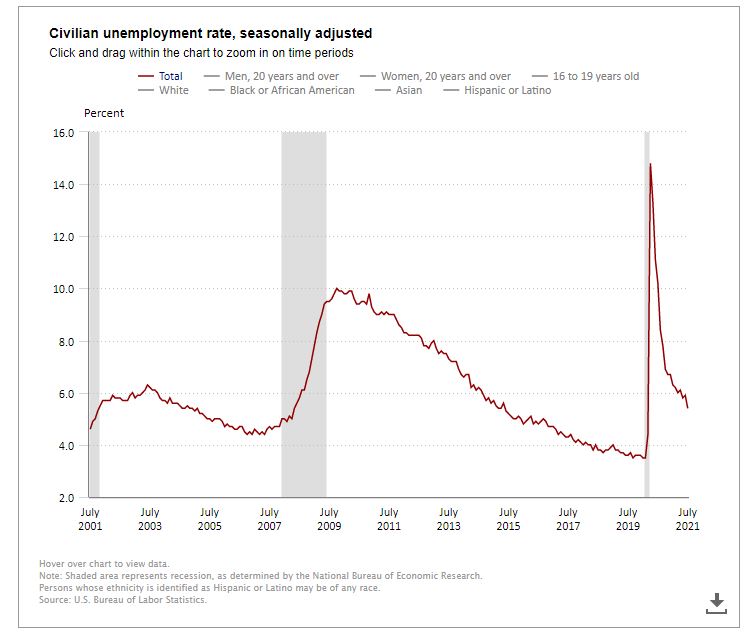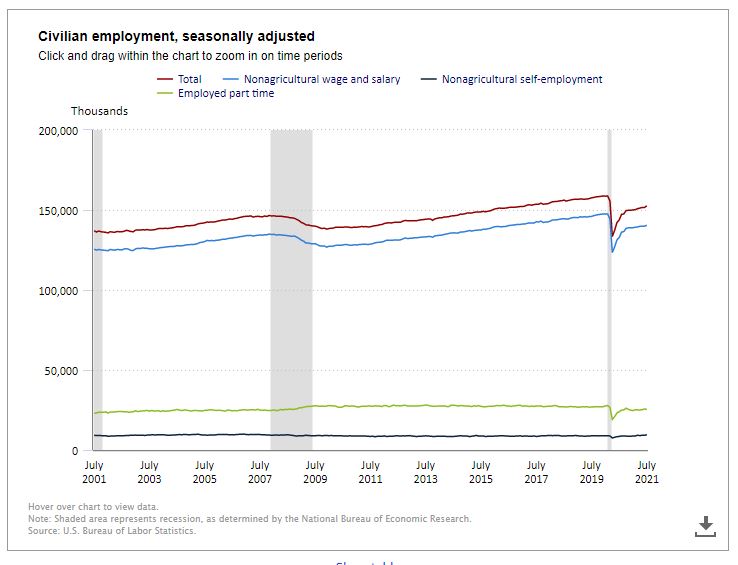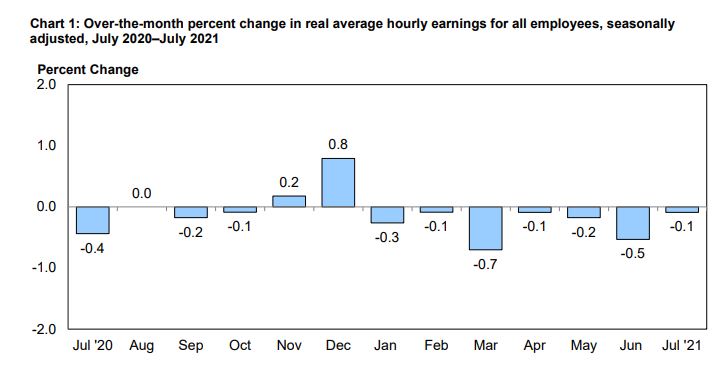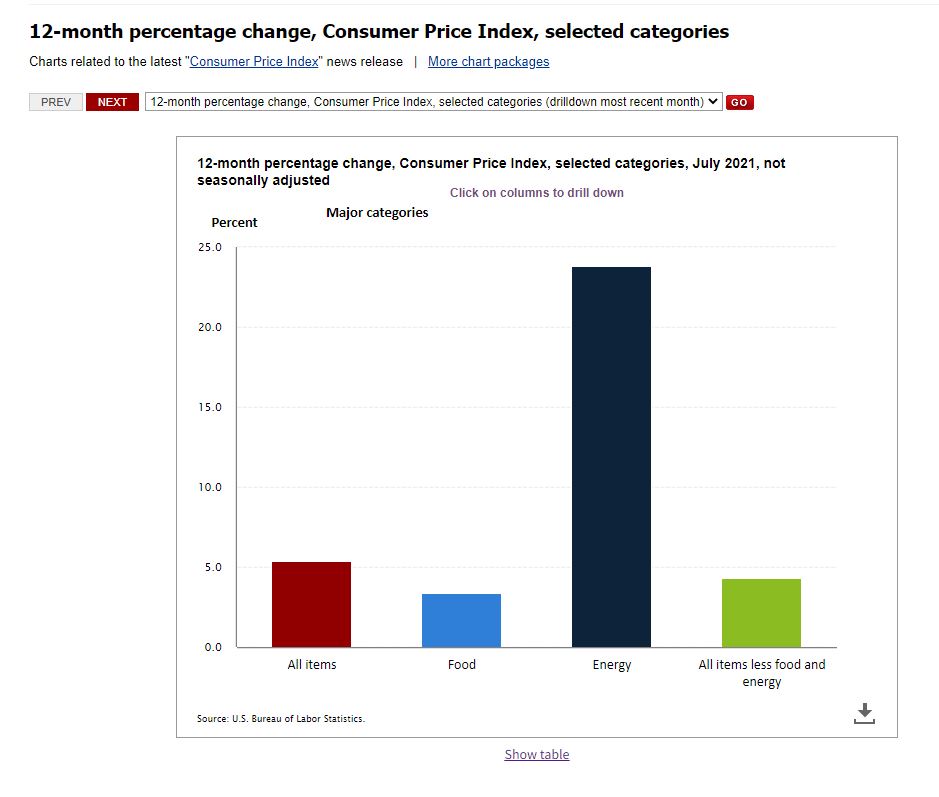Employment Blog August 2021
This information is from the U S Bureau of Labor Statistics, US Department of Labor. Nonfarm payroll employment increased by 943,000 in July, and the unemployment rate fell by 0.5 percentage point to 5.4 percent. Notable job gains occurred in leisure and hospitality, in local government education, and in professional and business services. Reflecting the initial impact of the coronavirus (COVID-19) pandemic on the labor market, job losses totaled 22.4 million during the February-April 2020 recession (-1.7 million in March and -20.7 million in April). As economic activity resumed, job gains in May through November totaled 12.6 million. Employment declined again in December (-306,000), following a surge in the number of coronavirus cases. Job growth restarted in January of this year, and nonfarm payroll employment has increased by 4.3 million over the past 7 months. However, employment is down by 5.7 million, or 3.7 percent, from the pre-pandemic employment peak in February 2020.


Strong job growth continued in leisure and hospitality, which added 380,000 jobs in July. Employment gains continued in food services and drinking places (+253,000); accommodation (+74,000); and arts, entertainment, and recreation (+53,000). Leisure and hospitality has added 2.1 million jobs since January and accounts for about half of all nonfarm jobs added thus far this year. However, employment in the industry is down by 1.7 million, or 10.3 percent, since February 2020.
Employment continued to increase in July in local government education (+221,000) and private education (+40,000). Pandemic-related staffing fluctuations in education have distorted the normal seasonal buildup and layoff patterns, likely contributing to the job gains in July. Without the earlier typical seasonal employment increases, fewer layoffs at the end of the school year can result in job gains after seasonal adjustment. These variations make it more challenging to discern current employment trends in education. Since February 2020, employment is down by 205,000 in local government education and by 207,000 in private education.
Employment in professional and business services rose by 60,000 in July. Within the industry, employment in the professional and technical services component rose by 43,000 over the month and is 121,000 higher than in February 2020. (Professional and technical services includes industries such as 3 accounting and bookkeeping services, management and technical consulting services, and scientific research and development services.) By contrast, employment in the administrative and waste services component (which includes temporary help services) changed little over the month (+20,000) and is 577,000 lower than in February 2020. Employment in the management of companies and enterprises component was also little changed over the month (-3,000) but is 100,000 lower than the level in February 2020. Employment in professional and business services overall is down by 556,000 since February 2020.
In July, transportation and warehousing added 50,000 jobs, with gains in transit and ground passenger transportation (+19,000), warehousing and storage (+11,000), couriers and messengers (+8,000), support activities for transportation (+6,000), and air transportation (+4,000). Overall, transportation and warehousing has added 534,000 jobs since April 2020; the industry has recovered 92.9 percent of the jobs lost during the February-April 2020 recession (-575,000).
Employment in the other services industry increased by 39,000 in July, with gains in membership associations and organizations (+17,000) and in personal and laundry services (+15,000). Employment in other services is down by 236,000 since February 2020.
In July, health care employment rose by 37,000, following little change in the prior 3 months. In July, job gains occurred in ambulatory health care services (+32,000) and hospitals (+18,000), while nursing and residential care facilities continued to lose jobs (-13,000). Health care employment is 502,000 below the February 2020 level.
Manufacturing added 27,000 jobs in July, with machinery (+7,000) and miscellaneous durable goods (+6,000) contributing to the gain. Overall, manufacturing employment is 433,000 lower than in February 2020.
Information employment grew by 24,000 in July, with three[1]fourths of the increase occurring in motion picture and sound recording industries (+18,000). Employment in information is 172,000 lower than in February 2020.
In July, financial activities added 22,000 jobs. Most of the gain occurred in real estate and rental and leasing (+18,000). Since February 2020, employment in financial activities is down by 48,000.
Mining employment rose in July (+7,000), largely in support activities for mining (+6,000). Mining employment has risen by 49,000 since a trough in August 2020 but is down by 103,000 since a peak in January 2019.
Employment in retail trade changed little in July (-6,000), following large increases in the prior 2 months. In July, job gains occurred in gasoline stations (+14,000), miscellaneous store retailers (+7,000), and nonstore retailers (+5,000), while building material and garden supply stores lost jobs (-34,000). Since February 2020, employment in retail trade is down by 270,000.
Employment in construction and wholesale trade showed little change over the month.
Real average hourly earnings for all employees decreased 0.1 percent from June to July, seasonally adjusted, the U.S. Bureau of Labor Statistics reported today. This result stems from an increase of 0.4 percent in average hourly earnings combined with an increase of 0.5 percent in the Consumer Price Index for All Urban Consumers (CPI-U). Real average weekly earnings decreased 0.1 percent over the month due to the change in real average hourly earnings combined with no change in the average workweek.


